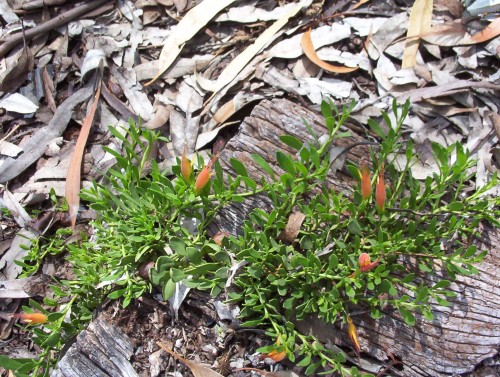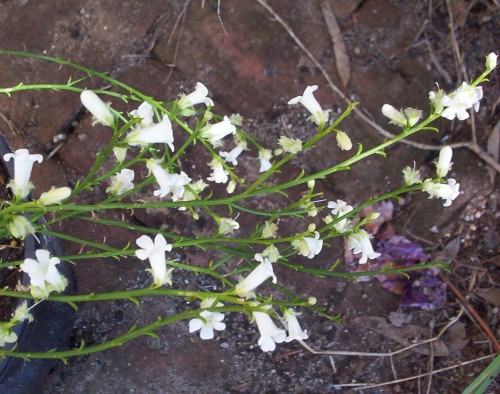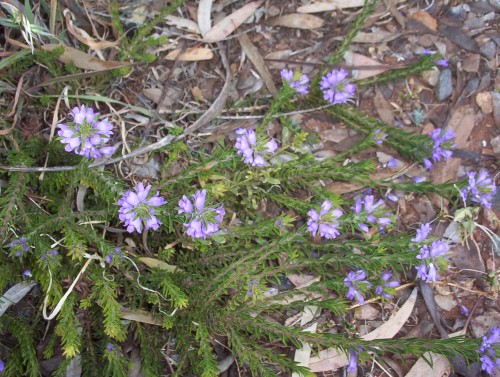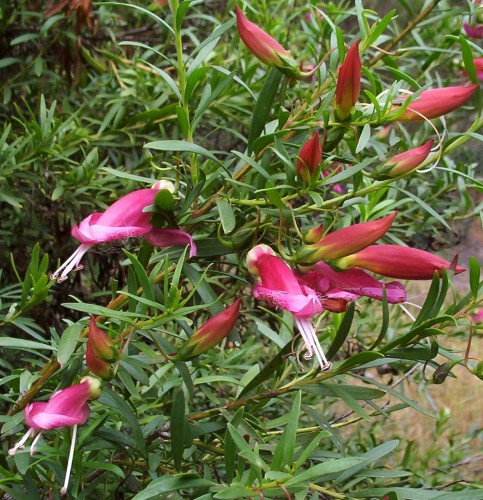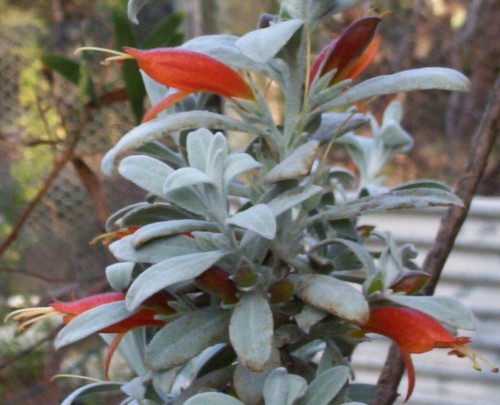Eremophila glabra ‘Roseworthy’
This is another of those tough glabra forms. This one originates from the Roseworthy district which is north of Adelaide in South Australia, on the road to the Barossa Valley. Many forms of native plants are named for the town or district where they grow and this is particularly so of Eremophilas.
This form of Eremophila glabra is quite flat like a lawn. In fact a well grown plant has the fresh green appearance of lawn and I am sure could be grown as a lawn substitute. It would only be visually like that as it could not be walked on like a lawn. However to have a flat green area is visually cooling even if it is not a true lawn. The plant would be worth growing for that alone. However another benefit is that Honeyeaters love the flowers which vary from yellow to red on the plant when in flower. This is a frost hardy plant also.
Eremophila dempsteri
This shrub is a little like ‘broom bush’ and grows between 1-4 metres tall. It originates from Western Australia in the area of Balladonia and Coolgardie and Salmon Gums in woodland areas. The plant rarely exceeds 1.5m on poorer soils.
I like this plant because even when the flowers have finished it maintains interest in the garden. The calyx and developing seed pods are densely hairy and, along with the flowering time, gives the appearance of flowering continuously for several months.
The flowers are usually lilac, but purple and white forms are also available.
Eremophila densifolia (prostrate form)
This is one of my favourite plants. I have been growing it for about 20 years and it has a few flowers most of the year with a main flush in spring and autumn. It is a low spreading plant. I have another form which is quite flat. Not a vigorous plant to be controlled but grows to about a metre (3 feet) wide in our poor soil. The one in the photo occasionally has branches to about 30cm (1 foot).
I have not seen any frost burn on the tips but occasionally caterpillars make webs in some branchlets and defoliate them. The colour is a deep purply blue and I have seen variations on this on other plants. It is a difficult colour to photograph.
Eremophila maculata (Spotted Emu Bush)
I have had this pretty dark pink form growing for 20 years in a windbreak/screen. I established it by watering with drippers as it was growing in amongst existing Eucalyptus (mallee trees). Over the years I have taken numerous cuttings from the bush and trimmed where webbing caterpillars had defoliated small branches. At flowering it gives a fabulous display and seems to have some flowers for most of the year with the major flowering in spring and autumn.
In our terrible soil the plant is about 1.7m high and wide. Our rainfall is about 3oomm. The current drought situation does not seem to affect the plant given that there is little moisture in the subsoil.
Eremophila glabra variety tomentosa (Emu Bush)
This is one of my favourite Eremophilas. The leaves are grey green and are softly furry which can be seen closeup to the plant (hence the variety name ‘tomentosa’). A microscope would give an even more dramatic view. With the bright red flowers for contrast it is a great bird attracting plant.
This is a plant for a dry position and well drained soil. It is about one and a half metres tall by about half a metre wide. It needs to be pruned after flowering to promote more new growth which of course produces more flowers.
There are a number of Eremophilas which come into the category of ‘glabra’, and a few others which have grey or whitish foliage with green, yellow, orange/red flowers.
